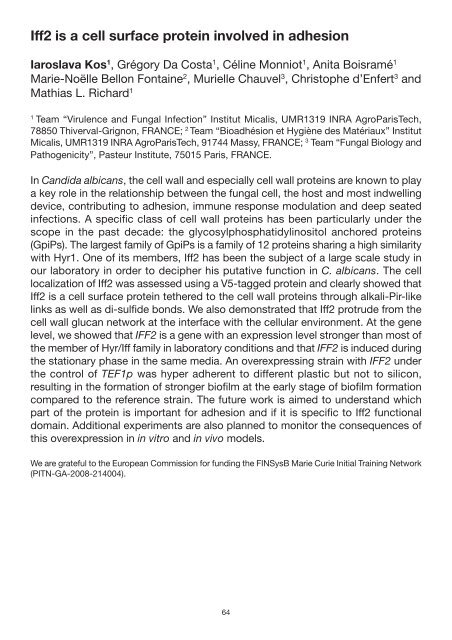Candida Infection Biology – fungal armoury, battlefields ... - FINSysB
Candida Infection Biology – fungal armoury, battlefields ... - FINSysB
Candida Infection Biology – fungal armoury, battlefields ... - FINSysB
Create successful ePaper yourself
Turn your PDF publications into a flip-book with our unique Google optimized e-Paper software.
Iff2 is a cell surface protein involved in adhesion<br />
Iaroslava Kos 1 , Grégory Da Costa 1 , Céline Monniot 1 , Anita Boisramé 1<br />
Marie-Noëlle Bellon Fontaine 2 , Murielle Chauvel 3 , Christophe d’Enfert 3 and<br />
Mathias L. Richard 1<br />
1 Team “Virulence and Fungal <strong>Infection</strong>” Institut Micalis, UMR1319 INRA AgroParisTech,<br />
78850 Thiverval-Grignon, FRANCE; 2 Team “Bioadhésion et Hygiène des Matériaux” Institut<br />
Micalis, UMR1319 INRA AgroParisTech, 91744 Massy, FRANCE; 3 Team “Fungal <strong>Biology</strong> and<br />
Pathogenicity”, Pasteur Institute, 75015 Paris, FRANCE.<br />
In <strong>Candida</strong> albicans, the cell wall and especially cell wall proteins are known to play<br />
a key role in the relationship between the <strong>fungal</strong> cell, the host and most indwelling<br />
device, contributing to adhesion, immune response modulation and deep seated<br />
infections. A specific class of cell wall proteins has been particularly under the<br />
scope in the past decade: the glycosylphosphatidylinositol anchored proteins<br />
(GpiPs). The largest family of GpiPs is a family of 12 proteins sharing a high similarity<br />
with Hyr1. One of its members, Iff2 has been the subject of a large scale study in<br />
our laboratory in order to decipher his putative function in C. albicans. The cell<br />
localization of Iff2 was assessed using a V5-tagged protein and clearly showed that<br />
Iff2 is a cell surface protein tethered to the cell wall proteins through alkali-Pir-like<br />
links as well as di-sulfide bonds. We also demonstrated that Iff2 protrude from the<br />
cell wall glucan network at the interface with the cellular environment. At the gene<br />
level, we showed that IFF2 is a gene with an expression level stronger than most of<br />
the member of Hyr/Iff family in laboratory conditions and that IFF2 is induced during<br />
the stationary phase in the same media. An overexpressing strain with IFF2 under<br />
the control of TEF1p was hyper adherent to different plastic but not to silicon,<br />
resulting in the formation of stronger biofilm at the early stage of biofilm formation<br />
compared to the reference strain. The future work is aimed to understand which<br />
part of the protein is important for adhesion and if it is specific to Iff2 functional<br />
domain. Additional experiments are also planned to monitor the consequences of<br />
this overexpression in in vitro and in vivo models.<br />
We are grateful to the European Commission for funding the <strong>FINSysB</strong> Marie Curie Initial Training Network<br />
(PITN-GA-2008-214004).<br />
64


